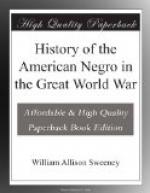In 1869 there was a general reduction in the infantry forces of the Regular army and the 38th and 41st were consolidated into one regiment numbered the 24th and the 39th and 40th into one regiment numbered the 25th. The strength and numerical titles of the cavalry were not changed. For over forty years the colored American was represented in our Regular Army by those four regiments. They have borne more than their proportionate share of hard service, including many Indian campaigns. The men have conducted themselves so worthily as to call forth the best praise of the highest military authorities. General Miles and General Merritt, actively identified with the Indian wars, were unstinting in their commendation of the valor and skill of Negro fighters.
Between 1869 and 1889, three colored men were regularly graduated and commissioned from the United States military academy at West Point and served in the Regular Army as officers. They were John H. Alexander, Charles Young and H.O. Flipper. The latter was dismissed. All served in the cavalry. Alexander died shortly before the Spanish-American war and up to the time of his demise, enjoyed the confidence and esteem of his associates, white and black. Young became major in the volunteer service during the Spanish-American war and was placed in command of the Ninth Battalion of Ohio volunteers. After the Spanish-American war he returned to the Regular Army with a reduced rank, but ultimately became a Major in that service. Upon America’s entry into the European war he was elevated to the rank of Colonel.
At the breaking out of the Spanish-American war in 1898, Negro military organizations existed principally in the Regular Army. These were soon filled to their maximum strength and the desire of Negroes north and south to enlist, seemed likely to meet with disappointment. Congress, to meet the insistence of colored men for service, authorized the raising of ten Negro volunteer regiments of “immunes”—men who had lived in sections where the yellow fever and other malignant or malarial visitations had occurred, and who had suffered from them or shown evidences that they in all probability would be immune from the diseases. The plan to place white men in all commands above the grade of second lieutenant, prevented Negroes from enlisting as they otherwise would have done. Four immune regiments were organized—the 7th, 8th, 9th and 10th.
Several of the states appreciating the value of the Negro as a soldier and in response to his intense desire to enlist, placed volunteer Negro organizations at the disposal of the government. There were the Third Alabama and Sixth Virginia Infantry; Eighth Illinois Infantry; Companies A and B Indiana Infantry; Thirty-third Kansas Infantry, and a battalion of the Ninth Ohio Infantry. The Eighth Illinois was officered by colored men throughout. J.R. Marshall its first colonel commanded the regiment during the Spanish-American war and did garrison duty in Santiago province for some time after the war; being for a while military governor of San Luis.




